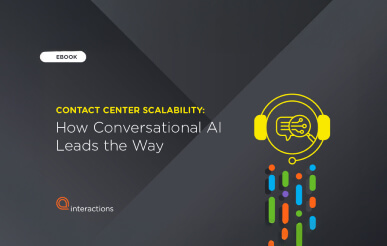A brand’s long term success and relevance is directly related to their appetite to innovate. We’re all heard the stories of brands who failed to challenge the status quo and deploy innovative technologies meant for the digital world. Think of Blockbuster, the once movie distribution giant of the early 2000s who didn’t accept the reality of their own digital transformation and eventually succumbed to disruptive new company, Netflix.
Technology decisions now drive business strategies as companies shift to the digital world. The role of a chief information office (CIO) is at the center of this shift, as CIOs are expected to be the change agents at their organizations and determine digital strategies. Once labeled ‘tech or IT experts’ CIOs must be business strategists as they embark on the journey to improve business outcomes, transform processes, modernize technology stacks, and ultimately improve customer experience. A CIO has to be a key leader involved in the evaluation of any disruptive technology to make sure it aligns with business priorities and strategy.
As brands are turning to digital investments to drive growth, CIOs are evaluating Conversational AI to be the center of their transformation.
A CIO’s Role in Improving CX
If CIO’s are focused on the adoption, evaluation, and deployment of digital technologies for their organization, then narrowing in on improvement to customer experience is the perfect place to start. According to IDC, 85% of enterprise decision-makers say they have a time frame of two years to make significant inroads into digital transformation or they will fall behind their competitors and suffer financially.
That’s because customer preferences are rapidly changing and these changes were amplified by COVID-19. The global pandemic driven digital adoption rates have covered decades of growth in days. According to a McKinsey report, there was 10 years worth of growth in eCommerce deliveries in just a mere 8 weeks, a 10 times increase in telemedicine virtual appointments in 15 days, and 250 million students transitioned to remote learning in 2 weeks. Brands now have the requirement to provide customers with digital touchpoints designed to enhance their experience and overall satisfaction because customer behavior has dramatically changed.
In a customer obsessed organization, CX is every leader’s responsibility but a CIO has a particularly important role to play.
- Define digital journeys: A CIO has the responsibility to identify, deploy, and scale the most innovative and promising digital tools within budget. These technologies should not only fit into the infrastructure of a company, but also support customer engagement.
- Set a digital foundation: A CIO must understand what integrations and partnerships are needed to truly transform an organization. This could look like technologies to enhance customer support and adding digital touchpoints.
- Manage general business management: A CIO must work with other internal leaders to mold the approach to digital business transformation.
Conversational AI is important to the success of a CIO because it has the capability to transform CX, the digital customer journey, and the strategy of an organization.
The days of the CIO offering simple IT advice to an organization are over. We’re now in the age of digital transformation and Conversational AI delivers just that. It shakes up what was once was a clunky, robotic, and analog approach to customer support and creates an experience that embraces the many necessary changes to technical infrastructures and information systems. Conversational AI completely adjusts the operating model of a typical customer experience department, but the entire organization will reap the benefits.
Put simply, Conversational AI makes speech technology seem more human by allowing customers to engage naturally, in their own words, to solve problems. It takes the frustration out of each customer touchpoint with a brand, ultimately increasing CSAT, revenue, and reducing operating costs.
In the last 10 years, we saw brands adding more and more channels to their engagement model in the spirit of digital transformation. While the intention was right, it brought forth a disjointed multichannel experience which the customers hate. Now CIOs must think about the optimum channel for each customer touchpoints, rather than simply just adding disconnected channels that cause more frustration. This cohesive strategy allows customers to reach a brand when they want, through the channel that’s most convenient to them, in their own words, without losing context. This combination of Conversational AI and channel optimization is the type of transformation that CIOs should be thinking about.
Conversational AI is a critical component to the data and technical strategy of a company because it has the capability to be completely transformative, improve the bottom line, and increase customer satisfaction — three top imperatives for a CIO.
How to Select Your Conversational AI Partner
Understanding that Conversational AI is necessary for any company is the first step, but there are other complexities for a CIO to reflect on.
- Selecting the right partner can make or break a Conversational AI deployment. A CIO should think through the strategic goals of Conversational AI and select a partner that aligns with that vision. This may include understanding what customer touchpoints should be automated first.
- Great Conversational AI relies on solid integrations with backend systems. There is a massive amount of internal preparation when deploying Conversational AI and a CIO should be ready to discuss the current state of legacy technologies and the integrations needed to truly personalize each customer interaction.
- Deep domain knowledge is essential. Building a Conversational AI solution for customer care requires a deep domain knowledge about the contact center and the customer experience industry.
- Automation on customer care channels will create data gold for a CIO, and they need to create a plan for analyzing and using this data to make improvements throughout the customer journey.
CIOs Lead the Conversational AI Charge
Embarking on a digital transformation journey is no easy feat. The planning, execution, and results often fall in the hands of a CIO because of their ability to look across the organization and think broadly about strategic imperatives. CIOs best understand the complexity of legacy technologies, the transformation of business outcomes, and modernization current customer experience channels. For these reasons, CIOs are the perfect sponsor of a Conversational AI initiative that will lead to the dramatic improvement of CX for their organizations.




